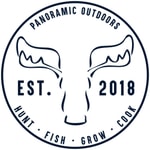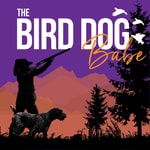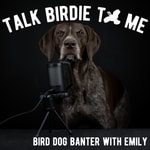Hunting Dog Confidential – Détails, épisodes et analyse
Détails du podcast
Informations techniques et générales issues du flux RSS du podcast.

Hunting Dog Confidential
Project Upland Media Group
Fréquence : 1 épisode/51j. Total Éps: 37

Explore the history, myths, and incredible stories of hunting dog breeds around the world. Co-hosted by Jennifer Wapenski and Craig Koshyk. A Project Upland Podcast.
Classements récents
Dernières positions dans les classements Apple Podcasts et Spotify.
Apple Podcasts
🇺🇸 États-Unis - nature
14/08/2025#56🇨🇦 Canada - nature
13/08/2025#94🇺🇸 États-Unis - nature
12/08/2025#69🇺🇸 États-Unis - nature
11/08/2025#51🇺🇸 États-Unis - nature
10/08/2025#60🇺🇸 États-Unis - nature
09/08/2025#60🇺🇸 États-Unis - nature
08/08/2025#94🇺🇸 États-Unis - nature
06/08/2025#90🇺🇸 États-Unis - nature
04/08/2025#80🇺🇸 États-Unis - nature
03/08/2025#92
Spotify
Aucun classement récent disponible
Liens partagés entre épisodes et podcasts
Liens présents dans les descriptions d'épisodes et autres podcasts les utilisant également.
See all- https://syrenusa.com/
36 partages
- http://dakota283.com/
17 partages
- https://youtu.be/BpDKXRh1z5c
1 partage
- https://youtu.be/51W-WcgCmDg
1 partage
Qualité et score du flux RSS
Évaluation technique de la qualité et de la structure du flux RSS.
See allScore global : 68%
Historique des publications
Répartition mensuelle des publications d'épisodes au fil des années.
The History and Debate of High Tails Versus Low Tails in Pointing Dogs
Saison 4 · Épisode 4
dimanche 1 juin 2025 • Durée 41:14
In this episode, Craig Koshyk explores two distinct perspectives on pointing dog tails—whether they should be held high or low. What might seem like a minor detail sparks a deeper debate shaped by centuries of breeding, cultural differences, and shifting hunting styles. Craig takes us back in time through research, art, photographic evidence, and written accounts from the early years of pointing dogs. He expands on his own personal experiences, from Europe to the United States, and offers theories on how and why these differences—and the strong opinions surrounding them—persist today.
Parts of this history have broader implications, including the crossbreeding of not just various hunting dog breeds but even hounds. It prompts us to think long and hard about whether the tail truly matters—and when it does, why it matters at all.
Listen to past episodes here: Hunting Dog Confidential Podcast
Breed, Strain, Variety, and Class: How Dog Breeds Got Their Names
Saison 4 · Épisode 3
mercredi 26 mars 2025 • Durée 35:15
In this episode, Craig Koshyk—renowned hunting dog historian and author—takes us on a deep dive into the fascinating world of breed names. From the earliest landraces to today’s officially recognized breeds, Craig unpacks how language, geography, and hunting traditions shaped the names we use for dogs today.
Through engaging stories and expert insight, Craig explores everything from the confusion around the word spaniel, to double-nosed pointers in Spain, to the meaning behind terms like braque, épagneul, and vizsla. Whether you’ve got a German Wirehair, a Picardy Spaniel, or a Labrador, this episode will give you a new appreciation for what your dog’s breed name really means—and where it came from.
Listen to past episodes here: Hunting Dog Confidential Podcast
Episode 27: A Sense of Place
Saison 3 · Épisode 27
jeudi 18 novembre 2021 • Durée 31:08
We are back with a new episode providing a sneak peek of season three of the Hunting Dog Confidential Podcast. Craig and Jennifer catch up on what they’ve been up to since the last episode (hint: they’ve been hunting with their dogs) and what’s new in the Hunting Dog Confidential world.
As a recap, season one explored the what…what breeds are used as hunting dogs and what were they developed to do. We did a quick survey of all the hunting dog breeds, ranging from pointing dogs to spaniels, retrievers, hounds, terriers, and many more. In season two, we explored the how… how are these dogs used to hunt and what are the methods people use with their dogs to hunt game. We explored traditional bird hunting with a pointing dog and a shotgun, we discussed small game hunting, big game tracking, driven hunts, and falconry.
Now, we want to dig a little deeper and establish a sense of place by asking where. The location where hunting dogs developed played a huge role in their characteristics and their use. This includes not only their geographic location, but also the time in which they were developed and refined. This is still true even today, where breeds can develop regional differences as dogs are bred to excel in the local terrain and culture where they are hunted.
The possibilities for exploring rabbit holes are endless and we are so excited to launch this new season by digging deeper into the stories behind our hunting dogs. This third layer will go even deeper into the cultural fabric and human connections where our hunting dogs were created and continue to be refined today.
As always, we thank you for listening and invite you to submit feedback or questions to us at HDC@northwoodscollective.com.
Share | Comment, review and discuss this episode of the podcast in our Project Upland Community Facebook group.
Enjoy the show and don’t forget to rate, review, subscribe, and share this podcast.
Hunting Dog Confidential is presented by Eukanuba Premium Performance Dog Food and supported by Dakota 283, Syren USA, SportDOG Brand and Kent Cartridge.
Episode 26: Hawking and Bird Dogs with Anthony Williams
Saison 2 · Épisode 26
mercredi 1 septembre 2021 • Durée 01:13:39
Anthony Williams is the epitome of versatility when it comes to the bird dog world. Growing up in Queens wasn’t going to dissuade him from his goals of hunting, running bird dogs, and flying a hawk. His initial exposure to birds was raising pigeons in urban New York, followed by his first experiences with falconry in an overgrown junkyard. This eventually led him toward bird dogs, where Anthony developed a love for the versatile breeds and also became a hound trial judge. Now, he has wirehaired Teckels, a Drahthaar, and a wirehaired Vizsla in addition to his hawks.
We follow a few rabbit trails with Anthony in discussing raising pigeons in the inner city, including pigeons that race and those that perform somersaults in the air. Many of us become familiar with pigeons during the course of training a pointing dog, but raising and competing with pigeons is a whole universe unto itself.
Turning to falconry, we discuss the various aspects of hunting with a bird of prey and how different species are particularly well-suited for different game and terrain. For example, hawks make great urban or suburban birds, but falcons are at their best when given lots of room to fly on the prairie or in the desert. Even the way in which the birds attack and kill their prey is different between species, so knowing your quarry is a key part in deciding which facet of falconry is right for you.
As always, we explore some of the unique language around falconry, such as the difference between hawking and falconry, why a male hawk is called a tiercel, and how the term “bird dog” actually refers to falconry rather than the pursuit of game birds.
Returning the discussion to dogs, we discuss the role of a dog in a partnership with a raptor and how it differs from hunting over a dog with a shotgun. We talk about the traits that work well and those that don’t, what’s expected of the dog, and how to train them for the task of hunting for a hawk or falcon.
Finally, Anthony shares some candid advice and wisdom on how to decide if you’re really up for the commitment of falconry—and if you’re serious about it, where to start learning more and taking your first steps toward becoming a falconer.
As always, we thank you for listening and invite you to submit feedback or questions to us at HDC@northwoodscollective.com. We would love to feature your questions in an upcoming episode! Record a voice memo and email it to us to be featured on the show and to have your question answered.
Share | Comment, review and discuss this episode of the podcast in our Project Upland Community Facebook group.
Enjoy the show and don’t forget to rate, review, subscribe, and share this podcast.
Hunting Dog Confidential is presented by Eukanuba Premium Performance Dog Food and supported by Dakota 283, Syren USA, SportDOG Brand and Kent Cartridge.
Episode 25: Conservation and Forestry Management in Germany with Nadja Niesner
Saison 2 · Épisode 25
samedi 10 juillet 2021 • Durée 01:04:55
This episode is the continuation of the discussion we started last time with German hunter and hunting instructor, Nadja Niesner. Before we get into the conversation, though, we address a listener question regarding the colors of hunting dogs. A simple question of “why do German hunting breeds tend to be darker and English breeds tend to have a white base” sent us down a long rabbit hole about the theories and origins of the variety of colors and patterns that dogs come in.
The overarching theme seems to be that selective breeding always involves the bias of the person doing the selecting, so personal preferences and ideas about camouflage or visibility influenced which dogs were selected for breeding. Color is also influenced by superstition, with black dogs sometimes having an association with evil or doom.
When selective dog breeding began but prior to a scientific understanding of color genetics, the nature of dominant versus recessive genes often caused questions about the “purity” of a litter. This led to the breeding of recessive colors, since two brown dogs would produce a litter of all brown dogs, as opposed to the dominant black gene which was capable of producing a variety of colors in the offspring.
Moving on to the continuation of our interview with Nadja, we picked up with a discussion about conservation and forestry management in Germany. We discuss how, for example, training with live ducks is limited to a certain number of ducks used over a dog’s lifetime. This reflects a federal government that seeks to strike a balance between developing hunting dogs but also preserving the limited resources of animals available for dog training.
We also discuss how dogs are used to hunt various predators and invasive species such as raccoons, raccoon dogs, foxes, and nutria. The German hunting culture is focused on a holistic approach to wildlife management, which not only involves the taking of game but also the control of predator populations to maintain a suitable equilibrium.
Finally, we discuss the changing demographics of hunting in Germany. As a hunting instructor, Nadja has a front row seat to the incoming hunter population and seeks to understand who is joining the community and why they were drawn to hunting. Just like in North America, most new hunters cite an interest in nature as well as a growing interest in knowing where their food comes from.
As always, we thank you for listening and invite you to submit feedback or questions to us at HDC@northwoodscollective.com. We would love to feature your questions in an upcoming episode! Record a voice memo and email it to us to be featured on the show and to have your question answered.
Share | Comment, review and discuss this episode of the podcast in our Project Upland Community Facebook group.
Enjoy the show and don’t forget to rate, review, subscribe, and share this podcast.
Hunting Dog Confidential is presented by Eukanuba Premium Performance Dog Food and supported by Dakota 283, Syren USA, and Kent Cartridge.
Episode 24: Big Game and German Utility Dogs with Nadja Niesner
Saison 2 · Épisode 24
vendredi 18 juin 2021 • Durée 01:11:16
We start this episode with a discussion about versatile dogs or, as they are known in Germany, “useful” or “practical” dogs. In North America they are primarily used for bird hunting, their roots stretch back to a variety of purposes related to hunting and tracking. We discuss a couple of fun examples of the usefulness of hunting dogs, including a Boykin Spaniel who finds and retrieves box turtles in the name of science, as well as a hunting dog that is used to locate invasive Burmese pythons in the Florida Everglades.
Our guest interview this week is with Nadja Niesner, a German hunter, dog breeder, and hunt test judge with a vast range of experiences in the German hunting dog world. Her primary breed of choice is the Weimaraner, but she also enjoys her Brandel Bracke, Fox Terrier, and Cocker Spaniels.
We discuss the mechanics of hunting in Germany, which is entirely unlike the North American experience. Hunters are required to undergo an extensive education and testing system in order to be licensed to hunt. Similarly, the dogs must be tested and evaluated for their abilities in the field. Hunting is taken very seriously not only as a recreational activity but also as a crucial management method for the wildlife of Germany.
We split this interview into two episodes, so this first installment focuses primarily on the hunting of big game such as roe deer, fallow deer, and boar. This is traditionally done in a large group setting with a driven hunt, where various dogs are released into the forest to move the game toward the waiting hunters. Contrary to what you might expect, the dogs do not chase all of the game out of the woods. Instead, they are expected to locate and carefully move the game without setting it off at a sprint. This allows for a safe encounter with the waiting hunters and a better overall experience for all participants.
Because the dog work is done almost entirely out of sight of the handler, it is important for the dogs to be spurlaut, or scent-loud, on the fresh track of the game animal. This alerts the hunters to the incoming game and, if you know your dog’s voice well enough, can even allow you to identify the species of game before it arrives.
The German philosophy and approach to hunting is unlike anything that most North Americans have ever experienced. This rich culture provides the context for some of our most popular bird dogs as well as the foundations of NAVHDA. Understanding this context can enrich your experience with your own versatile hunting dog.
As always, we thank you for listening and invite you to submit feedback or questions to us at HDC@northwoodscollective.com. We would love to feature your questions in an upcoming episode! Record a voice memo and email it to us to be featured on the show and to have your question answered.
Share | Comment, review and discuss this episode of the podcast in our Project Upland Community Facebook group.
Enjoy the show and don’t forget to rate, review, subscribe, and share this podcast.
Hunting Dog Confidential is presented by Eukanuba Premium Performance Dog Food and supported by Dakota 283, Syren USA, and Kent Cartridge.
Episode 23: Irish Water Spaniels with Russell Dodd
Saison 2 · Épisode 23
samedi 15 mai 2021 • Durée 01:15:04
We start this episode with a discussion about the practice of tail docking. Depending on where you are located, this may be a well-accepted practice or it may be controversial or even banned. We discuss the historical context of docking tails as well as the modern applications for working and hunting dogs. It’s our hope that this will better inform your discussions when this topic comes up in dog circles.
Our guest interview this week is with Russell Dodd, an AKC hunt test judge who has owned Irish Water Spaniels for many years. Although he grew up hunting, he did not get into bird hunting until he found this quirky dog breed who was at its best when hunting waterfowl and upland birds.
We discuss the characteristics of the Irish Water Spaniel and how it occupies an interesting space between the prey drive of traditional flushing spaniels and the devotion of traditional water retrievers. This “hybrid” personality may be seen as a versatile advantage or, perhaps sometimes, as an unwelcome surprise when the dog doesn’t always respond in the way that you expected. The bottom line, though, is that these are amazing dogs with an unquenchable desire to hunt in cooperation with their owner.
We also cover the details of AKC hunt tests for spaniels, which involve multiple testing segments covering upland hunting and water retrieving. While the Irish Water Spaniel may not be uniquely specialized for either of those tasks, its versatility makes it a great fit for AKC hunt tests.
It was also educational for two pointing dog owners to talk to someone who regularly hunts with a flushing dog. We discuss the safety elements involved in hunting with a spaniel and why steadiness is important for the dog’s safety and for the hunter’s peace of mind.
As always, we thank you for listening and invite you to submit feedback or questions to us at HDC@northwoodscollective.com. We would love to feature your questions in an upcoming episode! Record a voice memo and email it to us to be featured on the show and to have your question answered.
Share | Comment, review and discuss this episode of the podcast in our Project Upland Community Facebook group.
Hunting Dog Confidential is presented by Eukanuba Premium Performance Dog Food and supported by Dakota 283, Syren USA, and Kent Cartridge.
Episode 22: Nova Scotia Duck Tolling Retrievers with Grant St. Germain
Saison 2 · Épisode 22
jeudi 29 avril 2021 • Durée 01:07:43
We’ve been talking about the development of hunting dogs and how they were shaped by the humans and cultures where they originated. We received an interesting listener question asking us to consider the inverse of this concept: would human development have been any different if we did not have dogs at our side? It’s a fascinating thought experiment to consider what might have been different, which of course leads us down a few trails.
Back on the topic of hunting methods, we also addressed some listener input regarding the current status of hunting with crossbows across the United States. While their use (where legal) is primarily for big game hunting, we muse about the possibility of reenacting historic bird hunting methods…after you check your local regulations, of course!
Our guest interview this week is with a Canadian waterfowler who grew up hunting ducks in Nova Scotia. As a kid, Grant St. Germain was introduced to the Nova Scotia Duck Tolling Retriever, or Toller, through family friends who were among the early advocates for the breed.
Tolling for ducks means luring the ducks to shore and within shotgun range. This is an ideal technique on a calm day when ducks are rafted up offshore with no reason to move around or seek protection from the weather. The Toller is enticed to play and frolic along the shoreline, which triggers the ducks to move in for a closer look. As the ducks approach the shore, the concealed hunter waits for them to come within range and then jumps up for a couple of shots.
While the exact reasons for why the ducks are attracted to the dog are up for debate, Grant supposes that it’s related to their nest protection instinct. Since Tollers are bred to look and behave like foxes, it’s thought that ground-nesting ducks instinctively come to see the “fox” along the shore to see if it is raiding their nests. This theory is supported by the fact that tree-nesting ducks can’t be effectively tolled.
Utilizing the tolling technique is quite simple as long as you have the right kind of location where the rafted ducks can see the shoreline, yet you can remain hidden and close enough to the water. It’s typically an opportunity-based hunt when the situation presents itself, rather than something that can be planned in advanced.
There’s no special training required for the dog—you simply throw a stick or ball to get the Toller running back and forth along the shoreline in a playful manner. Tollers are passionate about retrieving, so this comes very naturally for them and they won’t tire of the game. The only trick is to make sure that the dog ignores the approaching ducks—one look in the wrong direction could spook the ducks and end the hunt.
Tolling is rarely practiced today, but there’s no reason the technique should be lost to history! If you give it a try with your dog, please let us know how it goes.
As always, we thank you for listening and invite you to submit feedback or questions to us at HDC@northwoodscollective.com. We would love to feature your questions in an upcoming episode! Record a voice memo and email it to us to be featured on the show and to have your question answered.
Share | Comment, review and discuss this episode of the podcast in our Project Upland Community Facebook group.
Enjoy the show and don’t forget to rate, review, subscribe, and share this podcast.
Hunting Dog Confidential is presented by Eukanuba Premium Performance Dog Food and supported by Dakota 283,
Episode 21: Hunting and Field Trials in Continental Europe with Marjolein Kamman-van Eijk
Saison 2 · Épisode 21
vendredi 16 avril 2021 • Durée 01:17:22
Continuing our discussion of the various methods with which hunters use hunting dogs, we discuss the origins of the term “gun dog” and how bird dogs developed right alongside modern firearms. Both pointing dogs and breech-loading shotguns tended to reach their peak at the same time in the same locations: the mid-nineteenth century in England, but not until the early twentieth century in places like North America. Because of their shared history, it’s no accident that bird dogs and bird guns were developed and perfected on similar timelines.
Our guest interview this week stayed in the pointing dog theme, but we stepped across the English Channel into continental Europe to explore hunting opportunities and the field trialing scene on the mainland. Marjolein Kamman-van Eijk is an accomplished field trialer, dog breeder, and all-around hunting dog enthusiast. She began with longhaired Weimaraners, but as her interest in field trials grew, she started keeping and breeding English Setters along with the Weims.
We discuss the challenges with hunting and training big-running setters in the limited space available in Holland, which often requires traveling to France just to allow the dogs to really run. While bird hunting is almost nonexistent in Holland, there are still plenty of opportunities to hunt hare and geese, although that style of hunting favors the versatile Weimaraner and not so much the field trial setters.
Marjolein’s passion for hunting has taken her across the Atlantic and to the prairies of Manitoba and North Dakota, which opened her eyes to what’s really possible with these dogs when the landscape is endless. She found a love for sharptailed grouse and that all-too-familiar scene of beautiful dogs working birds on the American landscape.
Unlike what we discussed in last week’s episode with David Hudson, the field trial scene in continental Europe is enormous. Hundreds of dogs are entered into big-stakes events, most of which are dominated by Italian lines of English Setters. We cover the ins and outs of running these events as an amateur and navigating this sport which is often dominated by professionals.
Finally, we explore the differences and similarities in hunting and trialing culture around the world, and how the dogs always find a way to adapt and thrive no matter the location or the limitations.
As always, we thank you for listening and invite you to submit feedback or questions to us at HDC@northwoodscollective.com . We would love to feature your questions in an upcoming episode! Record a voice memo and email it to us to be featured on the show and to have your question answered.
Share | Comment, review and discuss this episode of the podcast in our Project Upland Community Facebook group.
Enjoy the show and don’t forget to rate, review, subscribe, and share this podcast.
Hunting Dog Confidential is presented by Eukanuba Premium Performance Dog Food and supported by Dakota 283.
Episode 20: Pointers and Setters on the English Moors with David Hudson
Saison 2 · Épisode 20
vendredi 12 mars 2021 • Durée 58:30
Kicking off our exploration of the methods of hunting with a dog, we start on the grouse moors of England and Scotland. We welcome our first guest to the show, David Hudson, who is an author, photographer, and pointing dog enthusiast with a rich history in the world of Pointers and Setters in the UK.
Before we can get too far, a language lesson is in order. What we call “hunting” in North America is typically referred to as “shooting” in the UK; there, hunting refers to pursuing game with hounds. David describes a typical shooting day afield with Pointers and Setters, which is significantly different from the driven shoots which are more popular in English field sports.
British field trials are designed to mimic a typical day afield with this style of shooting. The key difference is that all of the trialing dogs will be walking along with the group, leashed and absolutely silent. Total silence is required of the dogs who are awaiting their turn to run. Any slight noise will result in immediate disqualification. As a result, British dogs are expected to be very calm and quiet in an otherwise highly stimulating environment.
The field trial scene in the UK is very small as it has only a niche following among enthusiasts. It is not nearly as lucrative as retriever trials, so it means that the participants are primarily doing it for love of the dogs. This small community is tight-knit and is often found cheering each other on as the dogs compete.
We discuss the lack of crossover between British and Irish Pointers and Setters and the rest of continental Europe, which traces back to early rabies quarantine laws. Despite vaccines being prevalent, the two communities really haven’t exchanged much in the way of field trial participation or dog breeding stock. Of course, England had to look to other places to rebuild their dog populations after two world wars, but never really continued importing dogs for their breeding programs.
Finally, we talk about the traditions of British shooting culture and the unique language that goes along with it. Tune in to learn the unexpected definitions of “eye wipe” and “feathering,” among others.
As always, we thank you for listening and invite you to submit feedback or questions to us at HDC@northwoodscollective.com . We would love to feature your questions in an upcoming episode! Record a voice memo and email it to us to be featured on the show and to have your question answered.
Share | Comment, review and discuss this episode of the podcast in our Project Upland Community Facebook group.
Enjoy the show and don’t forget to rate, review, subscribe, and share this podcast.
Hunting Dog Confidential is presented by Eukanuba Premium Performance Dog Food and supported by Dakota 283.








